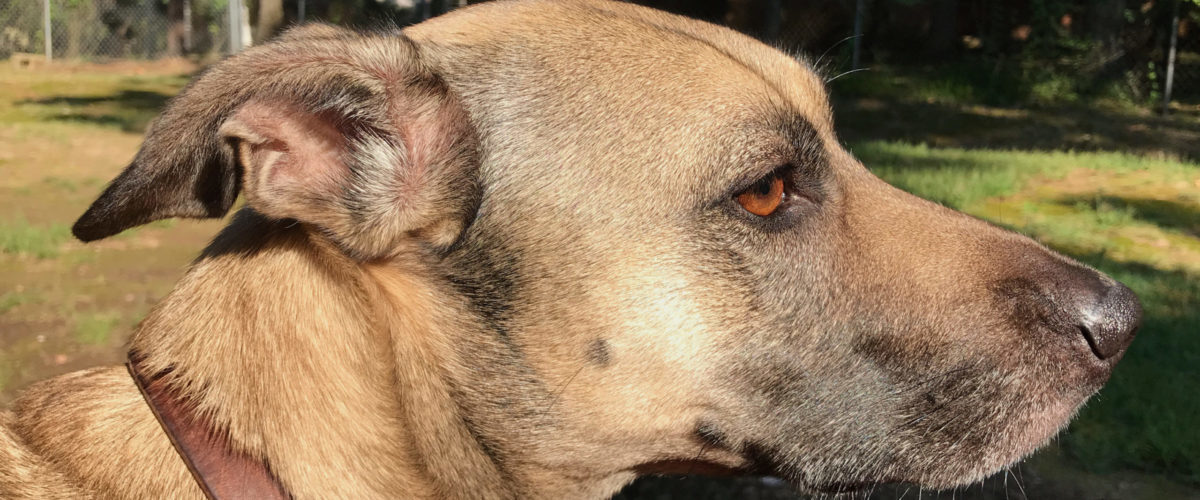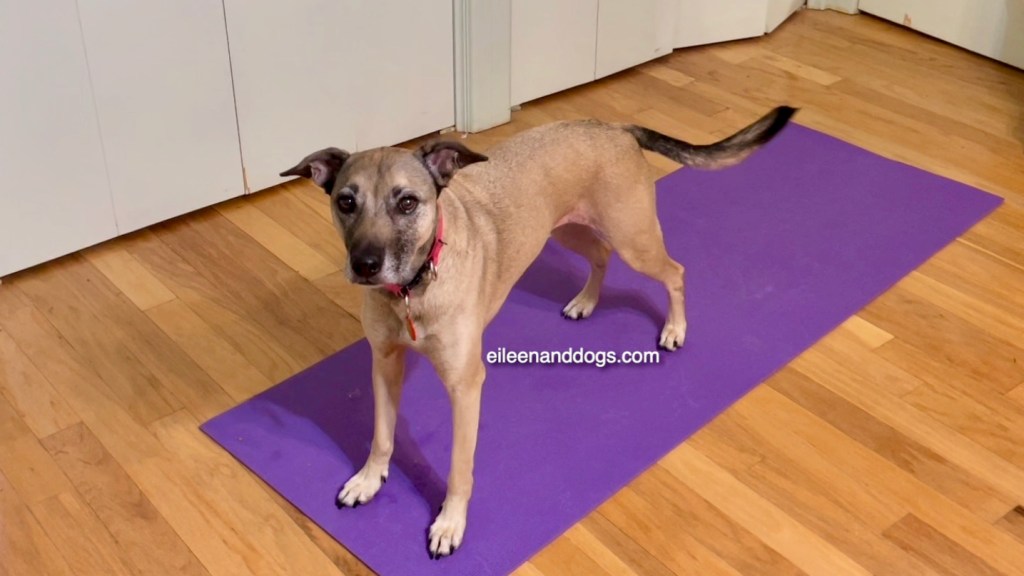Yes, this is part of the trick training series! Stand is one of the tricks we are working on. We just happened to touch on this long-standing can of worms created by my training!
I considered titling this post “Eileen’s Stand Disaster,” but I thought that might be too confusing. Clara was the one standing, but the disaster part was definitely on me.
Thousands of people worldwide have used Susan’ Garrett’s fun method for teaching the stand and gotten fabulous results. I wasn’t one of them, but I blame myself, not the method.
The method is to have the dog in heel position in a sit, and to use a hand target above the dog’s head to get them to leap into the air, hit the target with their nose, then land on four feet. It’s a fun, flashy behavior. But the activity got Clara over-aroused, and I didn’t know how to handle that.
When I casually mentioned on social media that Clara and I had bombed using Susan’ Garrett’s method, a group of angry fans came for me. But wait! I am a Susan Garrett fan, too! I took part in the very first Recaller’s Class, and that was probably the time I saw all three of my dogs at their happiest. I respect her work and have used lots of her methods, both in and out of agility settings.
My failure with that stand method was just that: my failure. Between Clara’s temperament and my weaknesses as a trainer, we had a wreck that kept on wrecking. Not every method works for every trainer’s skill level with every dog.
What Did the Disaster Look Like?
I messed around with the method for a couple of years, alternating between trying to make it work and trying to reteach stand another way. Here’s a video from that time. It’s pretty embarrassing, but things had been even worse earlier. You can see (and hear from my yelps) that Clara’s arousal level was a tremendous problem. I know better now how I helped ramp her up. I literally fed into it by feeding too rapidly and never adding duration. Shark creation.
And no, I don’t know why the half-squat position with her back legs crept into her stand!?
I do kind of wish I had that “leapfrog” behavior at 0:05 on cue, but I know better than to work on it! Another thing to notice is at 0:50 when, after trying unsuccessfully multiple times to get her to stand with a forward hand target, I give up and say “OK.” That, unfortunately, became the verbal cue for the behavior. What to me was a release cue, to her meant “stand.” You’ll see it in subsequent videos.
Clara is not always ramped up. She can melt into a mat and relax, and has successfully relaxed through every session of Dr. Karen Overall’s Relaxation Protocol in several locations. But jumpiness became part of the stand sessions.
Susan says in her video: “Even a six-year-old can do it.” Sigh. But I couldn’t, not with this dog.
Teaching Stand Successfully with Previous Dogs
I taught standing on cue to two other dogs with no problems. I taught Summer while training for competitive obedience and rally. I believe I used targeting but forward, not high in the air as in Susan’s method. Later, I taught Zani an adorable kickback stand using Sue Ailsby’s clever luring method: you lure them backward so they don’t step forward. Stand was the first and maybe only behavior I taught Zani by luring with food. I had to persuade her to follow the lure, since we had done so much leave-it practice.
This video of Zani is from 2018, after her spinal cord concussion. She couldn’t do a tight sit because of the effects of the spinal cord injury on her right rear leg, but she could still do the kickback.
Thanks for indulging me. Yeah, I posted this video partly to calm my ego, but also, damn, Zani was so cute!
What Were the Problems with Teaching Clara to Stand?
Clara gets aroused when she moves. A common problem, but I had not experienced it with any dogs before Clara. For instance, when we practice loose leash walking—ouch! She gets excited and super chompy when she gets treats while in motion. So when I taught her to leap from a sit or down and touch my hand in the air, then jammed food in her face when she hit the ground, I got her all worked up.
I was trying to capture the stand before she moved, so I shoved the treat into her mouth reallyreallyfast. And, predictably, got shark behavior in return.
Also, when Clara got confused about what we were doing, she would land in a sit or a down and stay there. I responded by giving my release cue to get her to move. She would stand, and I would reinforce. So the release cue (“OK”) became the cue for stand. By the time I added a real cue (“Brace”), I had already accidentally but firmly taught her to listen for “OK.” And it was unhandy that Clara popped into a stand whenever I tried to release her from anything.
I kept starting over with the process, so I got no duration.
I had an over-aroused, grabby dog who would bounce around nervously whenever I tried to train stand. Whatever I did with my reinforcement mechanics left her manically continuing to try other behaviors.
How I Solved the Problems
Clara already knows how to stand, of course, as does any dog with typical mobility. She stands dozens of times every day, meaning she performs both the motion of standing up from a sit or down, and the duration behavior of standing around. Standing in everyday life doesn’t arouse her; I created the arousal in our training.
A few months ago, I started over one more time. I took a page from my previous training and looked up my video on capturing stands. I thought I had made the video with Zani, but there was Clara, in 2015, with a nice little start on a fairly calm kickback stand! LOL, that’s what can happen when you write lots of blog posts and make lots of videos over the years! I think I had done that before I got her all overwrought with the jumping and targeting method! In the video, you’ll see her roach her back a couple of times, but her rear legs are in a much better position than the ultra-squatty stuff reinforced during the Bad Times.
So this year, I copied the steps from my own video.
First, I captured quiet stands for a while (not the behavior of standing up, just standing). I changed the picture from the method that didn’t work for us and stopped using the heel position setup. After sessions of capturing, I set her up facing me and waited. She offered movement into a stand quickly (but not nervously!). I was careful not to feed too fast, and I added duration as soon as I could. (One of my tragic flaws as a trainer is neglecting duration.) And I used a new cue—a flicking hand signal. No more “Brace” or “OK.”
This video from April 2021 through today shows our progress. She was still crouching somewhat with her hind legs in April, but that is mostly gone now.
Reinforcement History: Ghosts of Behaviors Past
But my “sort-of “victory isn’t the point of this post. I did some decent problem-solving. I was very patient. I got back a pretty nice stand behavior that we can continue to work on. You’ll see it in our next trick training video as well. But the nervous behaviors I reinforced during the stand practice still pop up frequently in training sessions of all sorts.
Behaviors rarely diminish all the way to zero. Clara unfortunately has a big reinforcement history for the debacle-stand. Here are a few examples of the attendant behaviors reappearing. And at the end, she does a perfect stand from a down (in response to my release cue) while I turn my back to go turn off the camera!
The concept of reinforcement history comes straight from Thorndike’s Law of Effect.
Of several responses made to the same situation, those which are accompanied or closely followed by satisfaction to the animal will, other things being equal, be more firmly connected with the situation, so that, when it recurs, they will be more likely to recur; those which are accompanied or closely followed by discomfort to the animal will, other things being equal, have their connections with that situation weakened, so that, when it recurs, they will be less likely to occur. The greater the satisfaction or discomfort, the greater the strengthening or weakening of the bond.
Thorndike, 1911, p. 244
The matching law quantifies the Law of Effect. The percentage of the time a behavior is reinforced will be reflected in how often the animal performs the behavior. So it’s a numbers game. If I stop reinforcing Clara for popping into a stand after I give the release cue (the last behavior in the above video), the stand will gradually decrease in that context. But the leapfrogging around in training sessions will be hard to eliminate because it got a ton of reinforcement in the past and gets chained into other behaviors I reinforce. You can see me reinforcing these chains throughout the video. The chain problem is not impossible to fix, but I need to sit down and think about whether I (with my own limitations) can carry out a plan without frustrating Clara, whether it’s worth it to try.
In the meantime, I’m pleased I am getting a semi-normal stand.
Copyright 2021 Eileen Anderson
Reference
Thorndike, Edward L (1911) Animal intelligence: Experimental Studies. Macmillan.

P.S. Although I didn’t categorize it that way, this post was born of the trick training we are working on. We aren’t through with tricks by a long shot!

